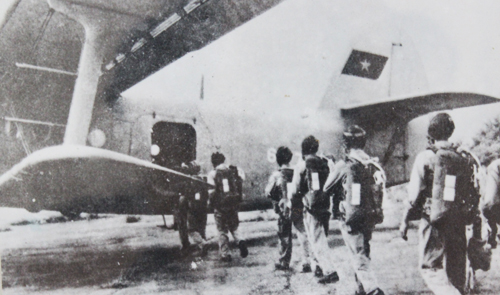After two training stages in China, parachuting brigade 305 returned to Vietnam with such responsibilities as airdropping supplies, acting as parachuting trainers, and setting up ‘airborne nets’ to trap US bombers.
Part 1: The first and only paratroop unit of the Vietnam armyPart 2: Vietnam paratroops train in China, work in Laos Part 3: Paratroop unit defends the sky of VietnamPart 4: Airdropping supplies during a dangerous mission in Hue
To train other parachutists, the brigade was moved from Bac Ninh Province to Bac Giang Province in the north, where there were vast training grounds inside military airports such as Kep, Buom, and Chu.
81-year-old colonel Duong Tuan Kiet of Da Nang, a member of the airborne brigade, recalled a regular training session when “hundreds of parachutes were carried from a warehouse of Kep airport to a training ground nearby.”
“The warehouse had several thousand parachutes gifted by the former USSR [now Russia]. Russia also sent five parachuting experts to Vietnam for training and many pilots as we had no pilot then,” Kiet said.
Parachutists, especially those during the training period, endured regular injuries such as bruises and sprains and other serious injuries, he added.
The parachutists performed difficult training sessions to learn how to land in varied terrains: in the mountains, by rivers, and by the sea. They also purposely practiced in harsh weather conditions such as fog and rain. A strong gust of wind could cause a parachutist to be stuck at the top of a tree.
Defending the sky
The units of parachuting brigade 305 invented a method to trap enemy bomber planes using ‘air defense nets’ and ‘airborne minefields’ in the sky of Hanoi and neighboring provinces. Balloons were the main ‘material’ to build traps to catch low-flying bombers.
“US bombers often flew low at night to avoid our radar system. Sometimes, the enemy flew just 50m above the water surface of Hong River. Our artillery forces were incapable of detecting and shooting them down.” Kiet said.
Kiet, who was then the head of the balloon team of Brigade 305, recalled that he had watched a history film that showed how the former USSR had used balloons to confront low-flying German planes during World War 2.
“I put forward the idea to leaders and it was later approved,” said Kiet. “The Ministry of Light Industry started the job by mass producing the balloons. The largest balloon was about an average arm span in diameter and could carry a load of four kilograms up to 400m high. The balloons were all blue in color to help disguise them in the sky.
“Three months after the idea was approved, the first “battlefields” of balloons were installed, flying at different heights from 50m to 400m at river mouths and other areas where US bombers usually flew low.
“We installed dozens of the airborne nets from Nam Dinh to Quang Ninh in an attempt to protect the west and southeast of northern Vietnam. A small ‘net’ had 200-300 balloons, while a big net had up to 700 balloons. Each balloon had a metal rope connecting to the ground to cause planes to crash,” Kiet said.
The first US bomber fell victim of the air defense net in January of 1967 and crashed in Bat Trang. Pilots of the plane failed to use its emergency parachuting system.
After that, technician Bui Duy Trinh installed claymore mines on the balloons to increase their effect.
Dam Trong, the former member of Brigade 305, added that he was one of many soldiers dispatched to install balloons, and every company was in charge of installing 50-60 balloons, each 200-300m apart.
It was a hard job to install balloons as each soldier had to carry 60kg and walk to the right places at the right time. Three or four soldiers were in charge of a balloon. The soldiers ate and slept outdoors.
“Soldiers installing in Quang Ninh were at greatest risk of being struck by lightning because the area has metal ores that attract more lightning,” Trong recalled. “Brigade 305 shot down two other enemy planes that way, one in Quang Tri in 1966 and the other in Ninh Binh in 1967.”
After that, enemy pilots chose to turn back when they recognized nets of balloons in northern Vietnam; if they flew any higher, they would fall prey to the artillery systems and missiles of Vietnam, he said.
However, Brigade 305 terminated its mission in 1967 following a decision by Minister of Defense General Vo Nguyen Giap because of changes in military situations.
The parachuting brigade was ‘upgraded’ to High Command of Commando on March 24, 1967 and colonel Nguyen Chi Diem became its first commander.





















































